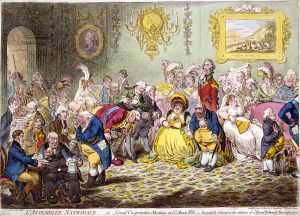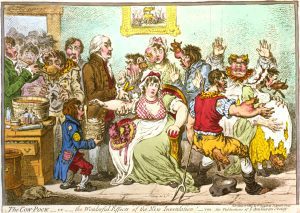When I first started blogging some five years ago I happened to buy Vic Gatrell’s book City of Laughter: Sex and Satire in Eighteenth-Century London at a local discount bookstore.1 I have never been the same since. Gatrell introduced me to the world of the Regency-era satirical caricacturist. As I began using their works in my blogs, my fascination increased. What was it that attracted me? Eventually I put a word to it … dash. These satirical prints have a bit of dash, a pinch of Go. Thus arose a name for my blog: Regency Dash.

“L’Assemblée Nationale” by James Gillray, 1804 (Wikimedia Commons)
The word “dash” may have originated in Scandinavia in the 1300’s. To dash, as in writing hurriedly, is from 1726. The Lexicon Balatronicum of 1811 reports two uses of the word “dash”: 1) to cut a dash or make a figure or serve as a tavern drawer (go figure!) and 2) The Go, meaning “the mode.”2
So many of the word’s general meanings describe the popular Regency-era prints such as the one by James Gillray shown above. To most of us in the early 21st century it looks like a typical gathering of Regency ladies and gentlemen. Several ladies sport white ostrich feathers on their heads, while a few hold fans. Several men are wearing yellow breeches; two officers appear in their red coats and epaulettes. A man is bowing to the presumed host and hostess. It looks like a typical assembly or levée.
Yet, the image is loaded with meaning. In fact, it has been called “the most talented caricature that has ever appeared.”3 Why? Look at the title: “A grand co-operative Meeting at St. Anne’s Hill [the residence of Charles James Fox], respectfully dedicated to the admirers of a Broad-Bottom’d Administration, 1804.”4 In the little scene of pure fiction shown above, Gillray has drawn the politician Charles James Fox—Britain’s first Foreign Secretary—holding a levée at his house in St. Anne’s Hill. The King of England, George III, has been executed [this never happened!] and the republic secured. All the leading Whigs are present [their likenesses are said to be quite excellent],5 and on the right-hand border is the left arm [dressed in bright blue] of the Prince of Wales.6 (In 1804 when Gillray published his engraving, the British government was Tory under William Pitt the Younger.) Apparently, the Prince was so offended by Gillray’s caricature that he paid to have it suppressed and destroyed.
Fortunately for us, the plate was not destroyed, giving us an opportunity to admire its satirical style and study the fashion of its figures. Jane Austen could “read” the meanings hidden in this image the way we read and understand today’s cartoonists. In fact, she would feel right at home in our 21st-century world where politicians of every stripe are regularly lampooned in the press.
For me, some of what I see here, in James Gillray’s engraving, is dash, the Go: a style all its own. That’s what I aim for in this blog: dash. I am compelled to write about the Regency from odd angles, perhaps because I seem to discover so many weird and wonderful things from that time period. Who but me would write about Johnstone’s London Commerical Guide (also here) and Matthew Flinders’ cat? I can only laugh.

“The Cow Pock” by James Gillray, 1802 (Wikimedia Commons) always makes me smile.
If you’re interested in other wonderful caricaturists during Jane Austen’s day, check out these links: Thomas Rowlandson, Isaac Cruikshank, George Cruikshank (son of Isaac), and Robert Cruikshank (another son of Isaac).
Sources:
1Gatrell, Vic. City of Laughter: Sex and Satire in Eighteenth-Century London. (New York: Walker & Company, 2006).
2Anon. Lexicon Balatronicum: A Dictionary of Buckish Slang, University Wit, and Pickpocket Eloquence. (London: C. Chappel, 1811), PDF pp. 73 and 102.
3Wright, T. and Evans, RH. Historical and Descriptive Account of the Caricatures of James Gillray. (London: Henry G. Bohn, 1851), p. ix (PDF p. 14).
4NOTE: A rather rough Gillray sketch shows the back view of the Broad-Bottom’d Administration.
5NOTE: A list of persons appearing in Gillray’s engraving, including Napoleon Bonaparte and Georgiana, Duchess of Deveonshire, can be found here (scroll down to the section labelled “Description”).
6NOTE: George, the Prince of Wales, ascended to the throne on his father’s death in 1820, becoming King George IV.
